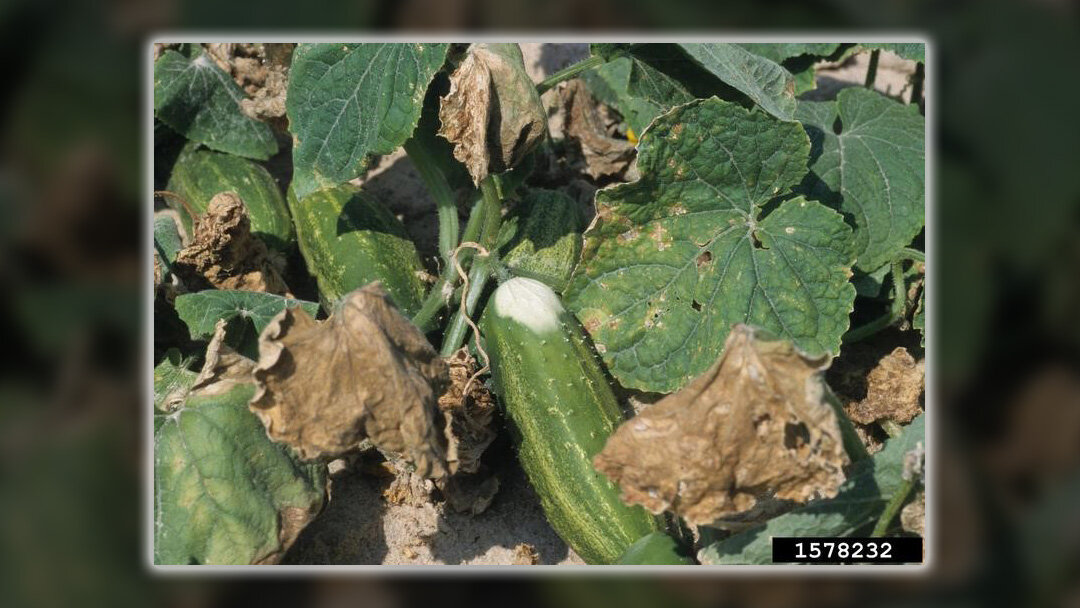Signs of heat stress in plants
/Sunscald on cucumber leaves and fruit. (Image: Gerald Holmes, Strawberry Center, Cal Poly San Luis Obispo, Bugwood.org)
Article by, Nicole Sanchez,
Horticulture, OSU Extension Service, Klamath County
Most plants grow best in temperature ranges 59-86F. When temperatures above 90F are sustained for long periods of time, plant growth is slowed, and some plants begin to show outward signs of stress. Above 104F, many plants will survive, but will show different signs of heat stress dependent on plant type, maturity of the plant, and factors that often come with high temperatures, such as drought or wind. Extreme air and soil temperatures slow down chemical activity and growth in plants.
Damage from heat stress shows up immediately in some plants, while in others visual effects may be delayed. A young, tender plant wilt within a few hours. In older, established plants, heat stress symptoms might show up later. For example, leaves that were developing during the high temperature period might not unfurl correctly, or may be distorted in some way. Fruit developing during high temperatures may show the effects days to weeks afterwards. The following are examples of the common signs that plants are stressed by extreme temperatures.
Leaf rolling and cupping: corn and tomatoes are among many plants that commonly use this mechanism. Leaf surface area is minimized, and stomata (microscopic openings in leaves, like pores, that allow movement of moisture and gasses) close. Together, these reduce moisture loss in the plant.
Wilting. Common in non-woody annuals and perennials, many plants will recover when temperatures drop. Wiling occurs when loss of moisture in the plant creates a lack of water pressure within the plant. Potential for permanent damage increases with the length of time that a plant remains wilted. Plants that wilt during the hottest part of the day, and recover in the evening and early morning, are likely suffering from heat stress.
Dry leaf edges. A survival mechanism used by some plant types is that the outer margins of a leaf will dry up, but the leaf as a whole remains viable. This may be more common in large-leaved plants like squash and pumpkin, where there is more leaf surface area to “spare” and still maintain function. Dry leaf edges can appear similar to disease symptoms.
Ozone damage. When high temperatures are combined with poor air quality, ozone damage is sometimes the result. In the Klamath Basin, where air inversions are common, ozone damage to tomatoes has been observed when hot temperatures and wildfire smoke are present. Ozone damage can also be confused with disease. In tomatoes, for instance, the dry brown spots in between leaf veins resemble bacterial leaf spot (the bacterial spots will have yellow “halos” that ozone damage does not). In cucumbers, squash and pumpkin, ozone damaged leaves become bleached and very dry looking.
Blossom and fruit drop. Numerous ornamentals abort or drop buds and flowers after prolonged exposure to high temperatures. This allows the plant to conserve resources for parts of the plant necessary for survival. Blossom and fruit drop is common in peppers, squash, and cucumbers when high temperatures persist. Most plants will return to typical production after a heat wave is over.
Bolting. A heat wave will likely mean the end for many cool weather plants like cilantro, broccoli and cauliflower, lettuce, and spinach. Bolting is the premature flowering of plants before they would typically be harvested. High temperatures induce bolting in cool-season vegetables. It may be helpful to harvest these foods when a heat wave is predicted, for best quality and flavor.
Sunscald. From apples to tomatoes to melons, many fruits will scald in high temperatures, primarily on the side of the fruit most exposed to the sun. Sunscald looks different on varying fruit types and may appear as a watery area on the fruit, discoloration, blisters on the skin of the fruit, dried out fruit, or sunken, hardened areas on the fruit surface. Blossom end rot, a common tomato problem associated with deficient calcium, can become more problematic when sunscald is present. Consistent watering helps minimize blossom end rot- avoid letting plants completely dry out between soaking.
Damaged fruit should be removed- secondary problems can develop when insects and bacteria take advantage of the compromised fruit surface. If removal of other damaged plant parts is necessary, it may be worthwhile to wait till the heat wave has passed to prune- pruning adds some additional stress to the plant. When possible, keeping plants well watered before they show signs of stress is ideal.



